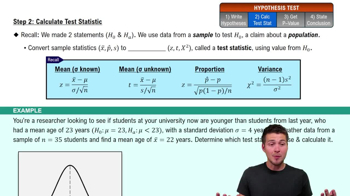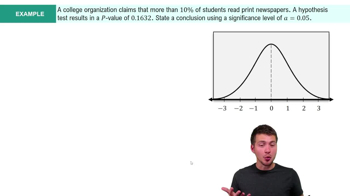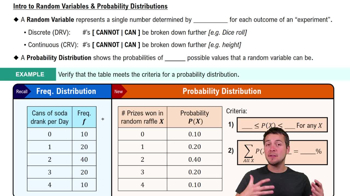a
Table of contents
- 1. Intro to Stats and Collecting Data1h 14m
- 2. Describing Data with Tables and Graphs1h 55m
- 3. Describing Data Numerically2h 5m
- 4. Probability2h 16m
- 5. Binomial Distribution & Discrete Random Variables3h 6m
- 6. Normal Distribution and Continuous Random Variables2h 11m
- 7. Sampling Distributions & Confidence Intervals: Mean3h 23m
- Sampling Distribution of the Sample Mean and Central Limit Theorem19m
- Distribution of Sample Mean - Excel23m
- Introduction to Confidence Intervals15m
- Confidence Intervals for Population Mean1h 18m
- Determining the Minimum Sample Size Required12m
- Finding Probabilities and T Critical Values - Excel28m
- Confidence Intervals for Population Means - Excel25m
- 8. Sampling Distributions & Confidence Intervals: Proportion1h 25m
- 9. Hypothesis Testing for One Sample3h 29m
- 10. Hypothesis Testing for Two Samples4h 50m
- Two Proportions1h 13m
- Two Proportions Hypothesis Test - Excel28m
- Two Means - Unknown, Unequal Variance1h 3m
- Two Means - Unknown Variances Hypothesis Test - Excel12m
- Two Means - Unknown, Equal Variance15m
- Two Means - Unknown, Equal Variances Hypothesis Test - Excel9m
- Two Means - Known Variance12m
- Two Means - Sigma Known Hypothesis Test - Excel21m
- Two Means - Matched Pairs (Dependent Samples)42m
- Matched Pairs Hypothesis Test - Excel12m
- 11. Correlation1h 6m
- 12. Regression1h 50m
- 13. Chi-Square Tests & Goodness of Fit1h 57m
- 14. ANOVA1h 57m
1. Intro to Stats and Collecting Data
Intro to Stats
Problem 1.1.17
Textbook Question
In Exercises 13–20, determine whether the results appear to have statistical significance, and also determine whether the results appear to have practical significance.
Election Fraud The County Clerk in Essex County, New Jersey, was responsible for randomly assigning the order in which candidates’ names appeared on a recent election ballot. Among 41 different ballots, a Democrat was placed on the first line 40 times, and a Republican was placed on the first line once.
 Verified step by step guidance
Verified step by step guidance1
Step 1: Define statistical significance. Statistical significance refers to the likelihood that a result or relationship is caused by something other than mere random chance. In this context, we need to determine if the observed distribution of candidates on the first line is unlikely to occur by random chance.
Step 2: Set up the null hypothesis. The null hypothesis typically states that there is no effect or no difference. Here, it would be that the placement of candidates on the first line is random, meaning each candidate has an equal chance of being placed first.
Step 3: Calculate the expected frequency under the null hypothesis. If the placement is random, each candidate (Democrat or Republican) should appear on the first line approximately half the time. With 41 ballots, the expected frequency for each party would be 20.5 times.
Step 4: Perform a statistical test. Use a chi-square test for goodness of fit to compare the observed frequencies (40 Democrats, 1 Republican) with the expected frequencies (20.5 Democrats, 20.5 Republicans). Calculate the chi-square statistic using the formula: , where O is the observed frequency and E is the expected frequency.
Step 5: Determine practical significance. Even if the result is statistically significant, consider whether it has practical significance. Practical significance refers to whether the result has real-world implications or importance. In this case, consider the impact of having one party consistently listed first on the ballot and whether it could influence voter behavior.
 Verified video answer for a similar problem:
Verified video answer for a similar problem:This video solution was recommended by our tutors as helpful for the problem above
Video duration:
3mPlay a video:
Was this helpful?
Key Concepts
Here are the essential concepts you must grasp in order to answer the question correctly.
Statistical Significance
Statistical significance refers to the likelihood that a result or relationship is caused by something other than mere random chance. In the context of the election fraud question, it involves determining if the observed pattern of ballot placements is unlikely under a fair random assignment, typically using a p-value to assess this probability.
Recommended video:
Guided course

Step 2: Calculate Test Statistic
Practical Significance
Practical significance considers whether a statistically significant result has real-world implications or importance. Even if the ballot placement pattern is statistically significant, practical significance asks whether this pattern affects the election outcome or voter behavior in a meaningful way, beyond just being statistically unusual.
Recommended video:
Guided course

Step 4: State Conclusion Example 4
Random Assignment
Random assignment is a process used to ensure that each candidate has an equal chance of being placed in any position on the ballot. In this scenario, understanding random assignment is crucial to evaluating whether the observed pattern of ballot placements deviates from what would be expected under fair conditions, thus indicating potential bias or manipulation.
Recommended video:
Guided course

Intro to Random Variables & Probability Distributions

 2:13m
2:13mWatch next
Master Introduction to Statistics Channel with a bite sized video explanation from Patrick
Start learningRelated Videos
Related Practice
Open Question
